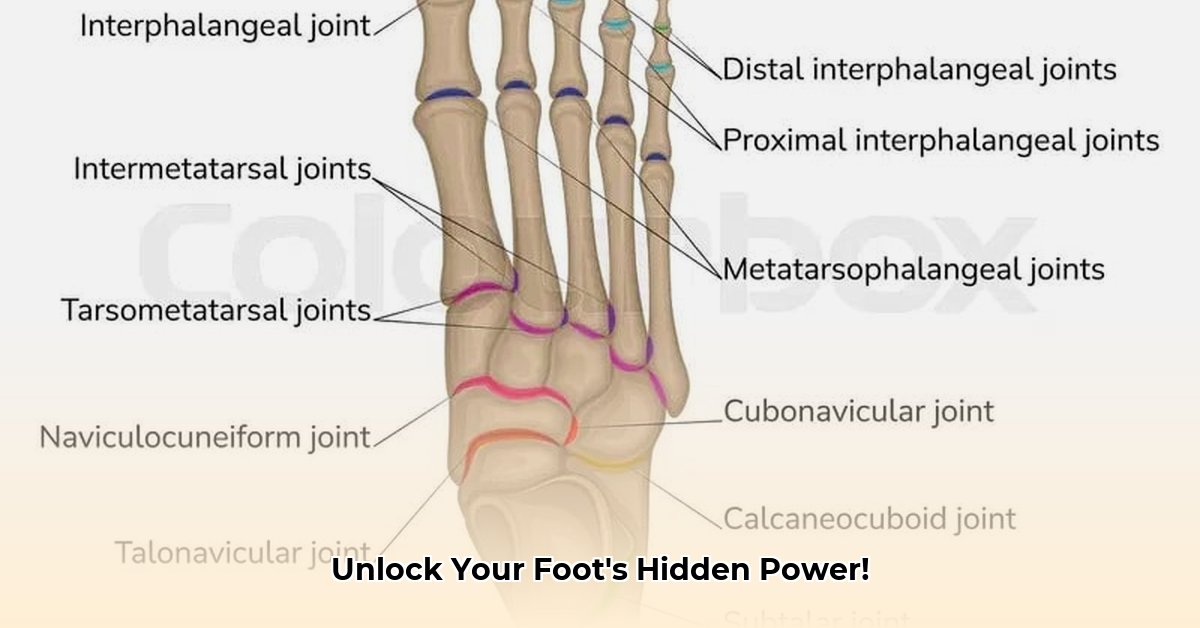
The Amazing Architecture Beneath Your Feet
Your feet are complex structures, each encompassing 26 bones, 33 joints, and over 100 muscles, tendons, and ligaments. This intricate system enables standing, walking, running, jumping, and maintaining balance. Understanding this intricate mechanism is key to injury prevention and overall foot health. Did you know that the intricate arrangement of bones and soft tissues in your feet allows for both incredible stability and surprising flexibility? For a visual guide to foot parts, check out this helpful resource: foot parts diagram.
The Bony Framework: Your Foot's Foundation
The foot's structure hinges on a robust bony framework, divided into three main sections:
Tarsals (rearfoot): Seven bones, including the calcaneus (heel bone) and talus (ankle bone), form the base of the foot. Think of these as the foundation upon which the rest is built.
Metatarsals (midfoot): Five long bones connect the tarsals to the toes, acting as a bridge between the heel and toes.
Phalanges (toes): Fourteen bones in total—two in the big toe and three in each of the others.
These bones collaboratively create three arches: the medial longitudinal (inner), lateral longitudinal (outer), and transverse (across the ball of the foot) arches. These arches act as shock absorbers, efficiently distributing weight and maintaining flexibility. Without these natural shock absorbers, every step would be jarringly painful. How many people underestimate the importance of these critical arches?
Joints and Ligaments: Flexibility and Stability
Bones are interconnected by joints, enabling movement and flexibility, and secured by ligaments—strong bands of tissue providing stability. These joints and ligaments work in tandem to create a system that allows for both fluid mobility and robust stability. Without them, your foot would be a wobbly, unstable mess.
Muscles: Power and Precision
Foot movement relies on intrinsic (within the foot) and extrinsic (extending from the leg) muscles. These muscles provide both power and precision, enabling everything from subtle balance adjustments to the powerful push-off during locomotion. Understanding their function helps appreciate the complex interplay of movement in your feet. What is the primary muscle responsible for plantar flexion? (The gastrocnemius and soleus muscles)
Tendons: The Power Cables
Tendons, fibrous cords connecting muscles to bones, act as cables, transferring muscle power to bones. They also play a vital role in shock absorption, safeguarding bones and joints from the impact of activity.
Understanding Common Foot Problems
Basic knowledge of foot anatomy aids in understanding common foot problems. While this isn't a medical substitute, this understanding facilitates better communication with healthcare professionals. Common issues include:
- Sprains: Ligament stretches or tears, often from sudden twists.
- Fractures: Bone breaks, typically from trauma.
- Plantar fasciitis: Inflammation of the plantar fascia (tissue on the bottom of the foot), often causing heel pain.
Keeping Your Feet Happy: Practical Steps
Understanding foot anatomy empowers proactive foot care. Here's how:
Supportive Footwear: Well-fitting shoes with proper arch support prevent many issues.
Foot Hygiene: Keeping feet clean and dry prevents fungal infections.
Regular Stretching: Improves flexibility and range of motion, reducing injury risk.
Professional Help: Don't ignore persistent foot pain; seek a podiatrist's advice.
This guide provides foundational knowledge of foot anatomy. By appreciating the intricate design and function of your feet, you can improve your foot health and overall well-being. Remember, your feet are your foundation—treat them well!
How to Improve Foot Biomechanics Through Proper Footwear Choices
Key Takeaways:
- Understanding foot anatomy is vital for selecting supportive footwear.
- Proper footwear significantly impacts foot health, reducing pain and injury risk.
- Shoe fit is paramount; ill-fitting shoes lead to various foot problems.
- Shock absorption and stiffness are key for injury prevention.
- Individual factors (foot morphology, activity level) affect optimal shoe selection.
The Foundation: Understanding Your Foot's Architecture
Your feet are intricate suspension systems, absorbing shock and propelling you forward. Key components include:
- Bones: Twenty-six bones provide structural support and leverage.
- Joints: Allow for flexibility and range of motion.
- Muscles, Tendons, and Ligaments: Stabilize the foot, control movement, and provide power.
- Arches: Act as shock absorbers and distribute weight efficiently.
How Footwear Impacts Foot Biomechanics
Improper footwear disrupts foot function, causing pain and injury. Proper footwear improves foot health and well-being.
- Support: Shoes need adequate arch support.
- Cushioning: Essential for shock absorption.
- Stability: Prevents excessive rolling.
- Fit: Shoes must comfortably accommodate your foot's shape.
Matching Shoes to Your Activity
Shoe selection depends on activity level and foot type. (See table in original draft for examples.)
Considering Your Unique Needs
Individual factors influence shoe selection. Consult a podiatrist for personalized advice. Choosing the right footwear isn't just about aesthetics; it’s an investment in your long-term foot health.